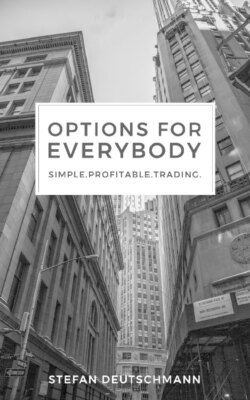Читать книгу Options for everybody - Stefan Deutschmann - Страница 16
Оглавление2.7 Option Moneyness (ITM, OTM, ATM)
At the beginning we repeat the term "strike". A strike price is the price at which we would build long or short exposures with an option. Unlike equities, where we are forced to trade the current price, we can choose different options that are above or below the stock price and have different premium values and profit probabilities. When choosing strikes, there are some key concepts that every trader needs to know: The probability that the option will expire worthless and whether the option is in the money (ITM), at the money (ATM) or out of the money (OTM).
In-the-money (ITM), Out-of-the-money (OTM) and At-the-money (ATM) are terms that describe the exercise price of the option contract compared to the current share price. ITM and OTM options have different effects depending on whether I have a long or short option. ITM options have a real (intrinsic) value at expiration, and OTM options only have extrinsic value. The ATM options are the strikes, closest to the current stock price. Remember that ITM is not profitable, it just means that the option has an intrinsic value. OTM options can be profitable before the expiration date, even if they never go ITM! So don't get confused by the terms.
Figure 7: „Moneyness" #1
For a put option (long or short), ITM is the option if the stock price is below the put exercise price (or the exercise price is above the stock price, whichever is easiest for you). If I have a long put at an exercise price of USD 60 and the stock is currently traded at USD 50, this option is in the money (ITM) because the long put allows me to sell 100 stocks at USD 60 instead of USD 50. If the option is traded for 12.50 USD, I know that 2.50 USD is extrinsic value because the option is 10.00 USD ITM. The principle of extrinsic and intrinsic values is discussed in the following chapters.
If I have a short put at 40 USD, this put option in the example above would be out of money (OTM). For a USD 50 stock, the USD 40 put would have no real (intrinsic) value at expiration. The put holder can sell shares in the market at a higher price than the put contract offers. As long as the stock is above USD 40 at expiration, I would be able to book the premium I initially received as a profit.
For a call option (long or short), the option is ITM if the stock price is ABOVE the strike price of the call (or the strike price is below the stock price, whichever is easiest for you). If I have a long call at an exercise price of USD 35 and the stock is currently traded at USD 50, this option is in the money (ITM) because the call allows me to buy 100 shares at a price of USD 35 instead of USD 50. If the option is traded for 15.50 USD, I know that 0.50 USD is an extrinsic value, as the option is 15.00 USD ITM.
Figure 8: „Moneyness“ #2
If I have a short call at 60 USD, the option would be "out of the money" (OTM). For a stock of 50 USD, the 60 USD call would have no real (intrinsic) value at expiration. The call holder can buy shares in the market at a lower price than the call contract offers. As long as the stock price at the end of my short call option is below USD 60, I would keep the premium as a profit.
When we sell options, we generally sell ATM or OTM options. Selling ITM options can be misleading as they have a higher price, but most of this value is an intrinsic value. This value will not change without the stock price changing. If I sell a call at a price of 10 USD for a total of 11 USD, in reality I can only earn 1 USD through the trade if the stock price stays exactly where it is until expiration. This is because the option initially had a value of 10 USD and the stock price would have to go down for the option value to go down.
Remember:
ITM OTM ATM are terms that describe the exercise price of the option contract compared to the current share price.
ITM options have an intrinsic value at expiration.
OTM options have only extrinsic value.
ATM options are strikes that come closest to the current share price.
As option sellers we want our options to be OTM at expiration, as option buyers we want them to be ITM.
